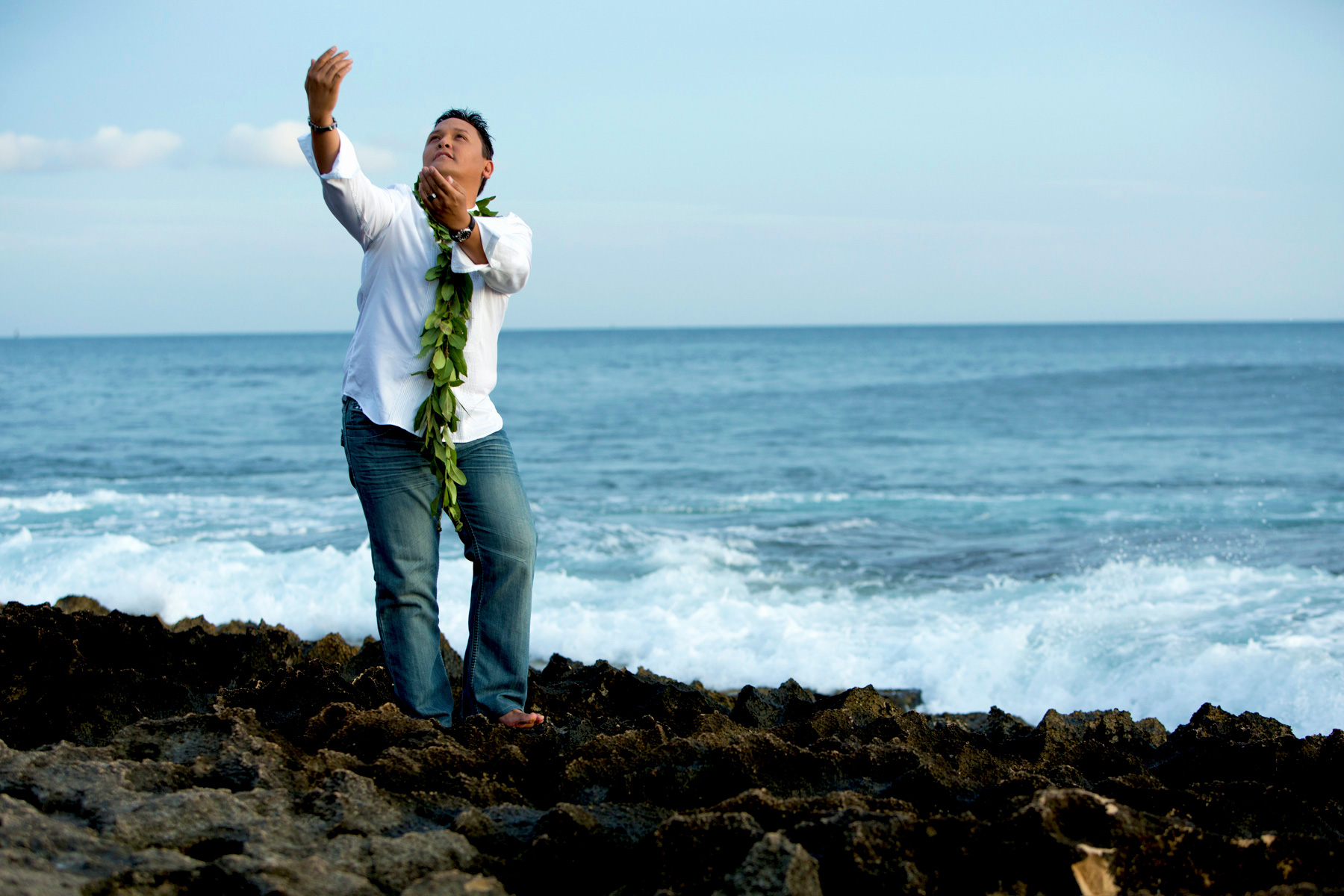The kūpuna of his family used music and hula to strengthen family ties and keep their keiki out of trouble. While Kumu Lōpaka’s father, Joseph De Vera, did not directly influence his hula journey, it was through his example he instilled in Kumu Lōpaka the work ethic, diligence, and humilty that hula would later require.
It wasn’t until the age of eight, however, that his admiration for and his desire to be like his sisters and cousins sparked his lasting interest in hula. His two elder cousins, Dedrick and Kalei, were members of The Men of Waimapuna under the direction of Kumu Hula Darrel Lupenui and his sisters danced for ʻIlima Hula Studio under the tutelage of Nā Kumu Hula Louise and Luka Kaleiki. Surprisingly, joining The Honolulu Boy Choir was the first step in fulfilling this desire. It was at the choir that he would hone his vocal abilities and also meet his first Kumu Hula, the late Carl Leroy “Hōkū” Rasmussen (choir instructor) and join his first hālau, Hālau Ku Aiwa Kama‘ehu. Kumu Lōpaka danced for Kumu Hōkū until his passing in 1984. He took a break from hula and joined the Polynesian group Pūpūkahi Oteʻa, which would later be known as Aloha Pumehana O Polynesia, under the direction of Dennis Kia and Denise Kauhionamauna Kia Ramento. He studied Polynesian dancing, drumming, and singing until he was 18 years old. Through his hula and Polynesian training, he went on to join Kawika Productions, Germaines Lūʻau, Tihati Productions, Hilton Hawaiian Village Kings Jubille, The Magic of Polynesia, and The Polynesian Cultural Center Promotional Team.
In 1990, at the age of 19, he met Kumu Hula Sonny Ching who was teaching at Pāki Park in Honolulu and joined Hālau Nā Mamo O Puʻuanahulu. His sisters, Kumu Lāhela and Kauʻi, would soon follow to become members. Coincidentally and unbeknownst to him, there was already a pilina between the two families that began with his mother and Kumu Sonny’s grand aunt Beatrice Nāhulu Lopes that maintained for 70 years until their passing. Additionally, his mother and aunts had danced for Kumu Sonny’s grandmother, Kumu Hula Lena Puaʻainahau Eleakala Nāhulu Guerrero in the 30s, 40s, and 50s. In September of 1993 he, along with three others, became Alakaʻi of HNMOP. It was at that time that he unknowingly embarked on his path toward becoming a Kumu Hula. He began developing his teaching skills with the keiki, the kāne, and later, the wāhine of the hālau. From 2000 to 2001, he groomed his vocal gift by studying oli with Kumu Hula Kealiʻi Reichel. It was in 2005 that he began to consciously purse his destiny as a Kumu Hula through an intense 6-year training for a Papa ʻŪniki. To aid his training, Kumu Sonny
gave Lōpaka the opportunity to relocate and travel between Honolulu and Soshigaya Okura and Yoyogi Koen, Japan to open and instruct Hālau Nā Mamo O Pu’uanahulu Iapana.
On October 7, 2011, the 25th Anniversary of Hālau Nā Mamo O Puʻuanahulu, in the quiet surroundings of Kaʻaʻawa, seven Alakaʻi had their ʻŪniki along with twelve ʻOlapa. While the “training” lasted 6 years, everything Kumu Sonny had taught them from the time they became members of the hālau was in preparation for that day. However, it was the Luna Loiloi—Kumu Hula Hōkūlani Holt-Padilla, Kumu Hula Kealiʻi Reichel, Kumu Hula Nālani Kanakaʻole, and Kumu Hula Leinaala Kalama Heine—that made the final decision as to whether the candidate would pass their ‘ūniki. It was especially prolific that Kumu Lōpaka and his sister, Kumu Lāhela, who had been a part of every important hula experience in his life, and the five other Alaka‘i would be deemed worthy of the title of Kumu Hula together. The following morning, Kumu Sonny presented his seven pua; the lālā of Hālau Nā Mamo O Puʻuanahulu, to their ʻOhana, Hoaloha, and fellow Kumu Hula. It was at this moment that all seven were welcomed into the guild of Kumu Hula publicly—it was one of the most beautiful experiences of his life.
When asked, “why do you want to become a Kumu Hula?” He replied, “this is what I am meant to be. I’m happiest when I dance, chant and sing. As a Kumu Hula, I get to represent our people, both past and present. It is humbling and such an honor. I also want to make a positive impression on the youth of today. I want to instill in them the importance of working hard and striving for goals through this art we call hula for the future of our people, culture and for future Kumu Hula. If we breathe our own breath into our dance, our haumāna, our hālau, we become unique as Poʻe Hula.”
Kumu Lōpaka continues to lead the Japan Hālau to this day. His favorite ‘Ōlelo No‘eau is:
E kuhikuhi pono i na au iki a me na au nui o ka ʻike
Instruct well in the little and the large currents of knowledge.
In teaching, do it well; the small details are as important as the large ones.
(Mary Kawena Pukui, ʻŌlelo Noʻeau Hawaiian Proverbs and Poetical)



